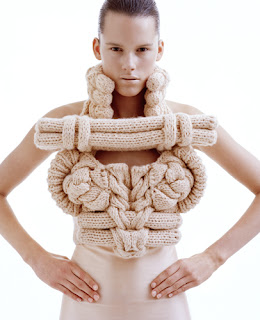I'm really excited to finally arrive at the technique of knotting! For me knotting exudes elegance yet it's drama is always captivating. I personally love Macramé, a versatile knotting technique that has been rather prevalent on the catwalks of recent. Macramé is the art and craft of decorative knotting. This means tying a variety of different knots to form specific patterns and/or original designs.
The word macramé is derived from the Arabic word migramah, which is traslated as “embroidered veil,” “ornamental fringe,” and “striped towel,” basically describes what this knotting technique was first used for. Macramé is believed to have originated around the thirteenth century when the Arabian weavers started decorating the edges of hand-loomed fabrics such as towels, shawls and veils, by knotting the excess thread that was left over along it, becoming beautiful decorative fringes. Hence, macramé was born as a result of the desire to make the final work look beautiful even up to its finest details; a creative and aesthetic way of dealing with what would otherwise be simple leftovers.
The art of macramé was introduced in Spain during the Moorish conquest, and from there it spread to the rest of Europe. The skill arrived to Italy and France in the early fourteenth and fifteenth century and was later introduced into England in the late 17th century at the court of Queen Mary, the wife of William of Orange, where it was used to embellish the elegant dresses and veils of the court members. During the Victorian Era this craft became a favorite, reaching homes where it was used to decorate curtains, lamp fringes, tablecloths, bed-spreads and clothes.
The Chinese adopted this craft and adapted it within their culture, from where a whole new set of knots and designs have been born. Chinese macramé is based on some basic knot types that are named according to their distinctive shapes, origins or particular uses. This is because Chinese culture makes great use of symbols, thus each knot has a symbolical meaning, representing values such as honesty, and feelings such as love or friendship. Therefore, Chinese macramé, in addition of having great aesthetic value for its original and perfectly symmetrical knots, adds a symbolic dimension to the ancient art of macramé. Chinese macramé has been treasured since ancient time for decorative purposes in places like Chinese palace halls to domestic homes, enhancing the look of lamps, draperies, mirrors, clothes, etc.
Macramé was popularized in North and South America during the 1960s and ‘70s by the hippie movement. Macramé clothes and jewelry became fashionable and many engaged in this art as a form of personal expression.;
 |
| Macramé Fashion, 1971. |
Macramé was a popular feature on the Spring/Summer catwalks 2011;
Gucci SS11
Gucci SS11
Proenza Schouler Autumn/Winter 2011
More Macramé;
Roberto Cavalli
Gianfranco Ferré
Alexander McQueen
Emilio Pucci
Jen Kao
Mark Fast
Rag & Bone
Eleanor Amoroso is a designer who works a lot with Macramé;
Knotting: Johan Ku;
Knotting: Sandra Backlund
Knotting: Danish knitwear designer Stine Ladefoged;
Knotting; D&G ready-to-wear Spring/Summer 2012
Knotting: Maj Anja Turesson, London College of Fashion BA womenswear 2009;


























.jpg)
.jpg)


.jpg)






No comments:
Post a Comment